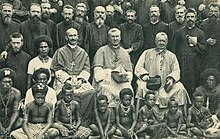Yule Island: Difference between revisions
m Reflist |
m Task 18 (cosmetic): eval 1 template: del empty params (3×); |
||
| Line 44: | Line 44: | ||
==History== |
==History== |
||
[[File:Yule.island.missionaries.1892.jpg|thumb|left|Missionaries and inhabitants after 1902]] |
[[File:Yule.island.missionaries.1892.jpg|thumb|left|Missionaries and inhabitants after 1902]] |
||
Yule Island was probably named after [[Charles Bampfield Yule]], a [[Royal Navy]] officer who surveyed the area from 1842–1845.<ref name=Quanchi>Quanchi, ''Historical Dictionary of the Discovery and Exploration of the Pacific Islands'', page 251</ref> It was one of the first areas in Central Province to have contact with Europeans. The [[Catholicism|Catholic]] [[Missionaries of the Sacred Heart]] began a mission in 1885.<ref>{{cite news |last=Sr Antoninus |
Yule Island was probably named after [[Charles Bampfield Yule]], a [[Royal Navy]] officer who surveyed the area from 1842–1845.<ref name=Quanchi>Quanchi, ''Historical Dictionary of the Discovery and Exploration of the Pacific Islands'', page 251</ref> It was one of the first areas in Central Province to have contact with Europeans. The [[Catholicism|Catholic]] [[Missionaries of the Sacred Heart]] began a mission in 1885.<ref>{{cite news |last=Sr Antoninus |date=1985 |title=Birds of paradise and drums that announce Christ's peace |url=http://jloughnan.tripod.com/birdsofpara.htm |work=[[Annals Australasia]] |archive-url=https://web.archive.org/web/20150907152232/http://jloughnan.tripod.com/birdsofpara.htm |archive-date=7 Sep 2015 |access-date=18 Jul 2020}}</ref> The mission was successfully led from 1900 to 1945 by Bishop [[Alain-Marie Guynot de Boismenu]].<ref>R. Tamamai, [http://asopa.typepad.com/asopa_people/2014/04/yule-islands-pioneer-bishop-de-boismenu-on-the-way-to-sainthood.html Yule Island's pioneer Bishop de Boismenu on the path to sainthood], ''PNG Attitude'', 26 Apr 2014.</ref> |
||
With the European missionaries came [[catechist]]s from the [[Philippines]], some of which married into the local population. Today, many inhabitants of Yule Island have distinct Filipino features.<ref>Hernandez</ref> |
With the European missionaries came [[catechist]]s from the [[Philippines]], some of which married into the local population. Today, many inhabitants of Yule Island have distinct Filipino features.<ref>Hernandez</ref> |
||
Revision as of 22:23, 3 December 2020
| Geography | |
|---|---|
| Coordinates | 8°49′S 146°32′E / 8.817°S 146.533°E |
| Administration | |
| Province | Central Province |
Yule Island is a small island in Central Province, Papua New Guinea. It is located 160 km NW from Port Moresby, on the south coast of Papua New Guinea.
History

Yule Island was probably named after Charles Bampfield Yule, a Royal Navy officer who surveyed the area from 1842–1845.[1] It was one of the first areas in Central Province to have contact with Europeans. The Catholic Missionaries of the Sacred Heart began a mission in 1885.[2] The mission was successfully led from 1900 to 1945 by Bishop Alain-Marie Guynot de Boismenu.[3]
With the European missionaries came catechists from the Philippines, some of which married into the local population. Today, many inhabitants of Yule Island have distinct Filipino features.[4]
The visit of Australian poet James McAuley to the mission at Yule Island in 1949 made a profound spiritual impression on him and contributed to his conversion to Catholicism.[5]
Fauna
Yule Island is surrounded by coral reefs.[6]
Several spider species are endemic to this island, including:[7]
- The jumping spider species Salticus perogaster and Plexippus brachypus
- Heteropoda cyanognatha and Pandercetes longipes (Sparassidae)
- Misumena arrogans and Stephanopis yulensis (Thomisidae)
The Early Pliocene Echinodermata fauna is rich and diverse, with 19 species known to occur in the Kairuku Formation. Nearly half of these species are also represented in northern Australia stocks, with the northern Great Barrier Reef only 600 km away.[8]
References
- ^ Quanchi, Historical Dictionary of the Discovery and Exploration of the Pacific Islands, page 251
- ^ Sr Antoninus (1985). "Birds of paradise and drums that announce Christ's peace". Annals Australasia. Archived from the original on 7 Sep 2015. Retrieved 18 Jul 2020.
- ^ R. Tamamai, Yule Island's pioneer Bishop de Boismenu on the path to sainthood, PNG Attitude, 26 Apr 2014.
- ^ Hernandez
- ^ J. Page, Land of Apocalypse – James McAuley’s encounter with the Spirit: the French Catholic Mission of the Sacred Heart, Kubuna, New Guinea, Journal of the Australian Catholic Historical Society, 37 (1) (2016), 18-31.
- ^ Papua New Guinea Tourism Promotion Authority
- ^ World Spider Catalog
- ^ nomen nudum 28: report 2001-2002 Archived September 2, 2007, at the Wayback Machine
- Papua New Guinea Tourism Promotion Authority: Central Province
- Platnick, Norman I.(2007): The world spider catalog, version 8.0. American Museum of Natural History.
Further reading
- Lindley, I. David (2003): Echinoids of the Kairuku Formation (Lower Pliocene), Yule Island, Papua New Guinea: Clypeasteroida. Regularia. Spatangoida. Proceedings of the Linnean Society of New South Wales 124: 125–162.
- Lindley, I. David (2004): The Yule Island fauna and the origin of tropical northern Australian echinoid (Echinodermata) faunas. Proceedings of the Linnean Society of New South Wales 125: 97-109.

